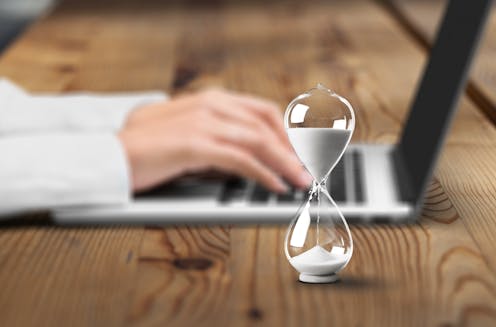
As I’ve been organizing this year’s International Association of Time Use Research (IATUR) conference in Montréal, I’ve been asked: What do you mean by time use research?
Behind this simple and descriptive name lies a body of diverse research that has advanced understanding on many contemporary social issues. But it seems that the concept is so broad that people have a hard time making sense of it.
Time use research is a research method that investigates how people use their time. Time use surveys gather data sequentially in the form of a journal of daily activities, from a person’s rise in the morning until bedtime. Each activity is recorded in a diary along with its location, and beginning and end time. Other attributes of activities are sometimes recorded, like who was present and the degree of enjoyment of the activity.

Tracking time
Time use surveys help gather detailed information on the time people spend doing various activities — including work, travel, leisure, chores or sleep — and their scheduling and sequencing over a day.
Traditional use of paper-based diaries have been adapted in response to changing technologies. Increasingly, online or phone-based apps are used to ease the burden for respondents.
I’ve started using these surveys to conduct research in my field of transport and mobility, but others use them in public health, sociology, economics, psychology and leisure studies. While transportation studies typically rely on travel surveys, time use surveys can additionally nest people’s travels within their daily schedules and lifestyles.
Time use surveys were useful in my research on the relationship between telecommuting and travel, and whether our increasing use of information technologies to shop, socialize and access information decreases the amount of travel we do.
For others, information gathered through time use surveys can help understand issues such as gender and cultural differences, assess the impact of policies by comparing jurisdictions and observe the evolution of societies’ use of time.
Over a century of data
If this field of study is relatively little known, it is perhaps because it proposes a generalist approach that more field-specific data collection completes, or simply because the popular press focuses on research findings, not on how they are arrived at.
Yet time use surveys have been used at least as early as 1900 and have helped generate significant insights about society. This includes developing important early knowledge on the labour force and patterns of work, especially in rural areas and on women’s economic contribution to households.
New questions are emerging and driving continued interest in time use surveys. People are spending more time online and alone, and tasks and activities are becoming more fragmented. Our impacts on climate change, for example, can be examined by studying time-based energy demands in residential buildings.
And time use surveys will prove useful in understanding the changes that crises like the COVID-19 pandemic have wrought, and how these will appear over time.
New technologies
Technology has become more powerful and able to combine and process larger amounts of data. Recent research is becoming possible because of innovative ways to administer surveys or to combine them with other forms of data capture. For instance, by enabling passive (but consensual) data capture, smartphone or tablet-based time use surveys can collect additional information, including geolocation for activities and periods when the device was under use. Time spent in and out of home, multitasking and time spent online can now be assessed more accurately.
There are also new approaches to presenting data, such as this dynamic visual representation from the Hungarian Central Statistical Office, that compares the daily habits of populations of different countries.
Global research
Time use research now takes place across the globe, and data harmonization efforts are becoming increasingly important. Now time use surveys are being used by the UN’s Sustainable Development Goals to measure gender differences in unpaid labor among other things.
Researchers are increasingly turning to time use research for detailed information. A pre-conference workshop at the 2022 IATUR conference will focus on helping improve measurement and propose new opportunities for time use research in achieving the UN Sustainable Development Goals.
Ugo Lachapelle receives funding from various organisations including the Social Sciences and Humanities Research Council of Canada (SSHRC). The conference mentioned here has also received funding from SSHRC.
This article was originally published on The Conversation. Read the original article.







